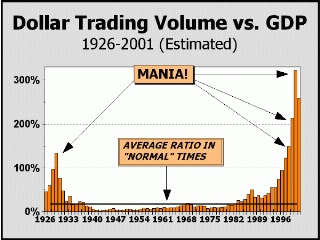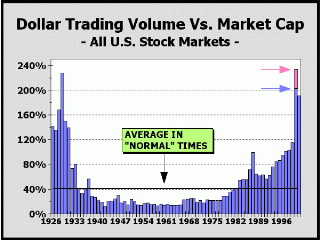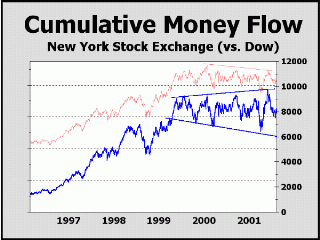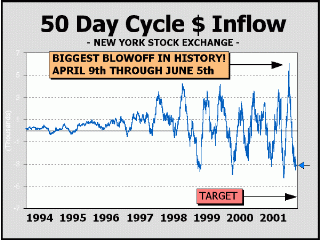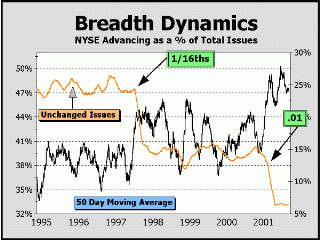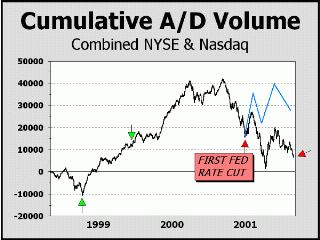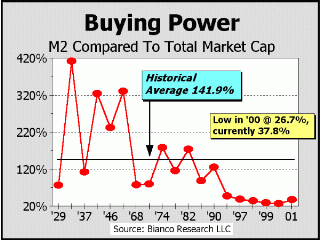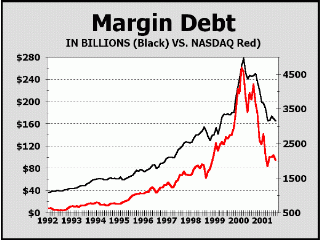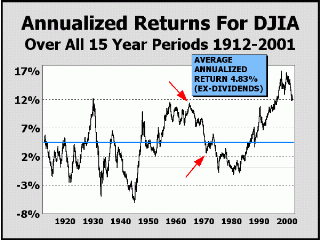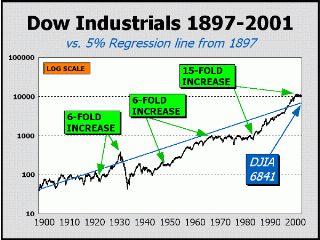
|
CHART DATA THROUGH AUGUST 21, 2001 A SPECIAL REPORT BY ALAN M. NEWMAN, EDITOR LONGBOAT GLOBAL ADVISORS CROSSCURRENTS |
| The mania continues to amaze,
offering history new chapters in human folly and circumstances beyond belief.
For the latter, we cite the Nasdaq 100 Trust (QQQ), also known as "Cubes."
The Cubes are issued by a trust that holds the stocks of the Nasdaq 100
index and were first listed on March 10, 1999 by the American Stock Exchange.
As the trust gained in popularity from inception, it needed to buy the
shares of the underlying companies. The demand became a substantial
reservoir of buying power that probably had a lot to do with the upwards
explosion of Nasdaq share prices. Growth has surged from 300 thousand
shares at inception to 134 million a year ago and 532 million today.
The rapid growth of Cubes has quite obviously provided support for Nasdaq's
top companies, even as their fundamentals have crumbled and earnings have
disappeared. As we suggested in a recent issue of Crosscurrents,
dealers who see the order flow believe institutions, not individuals, are
driving the market. With the Cubes liquidity now so high, it is believed
that mutual fund managers are now substituting them for the cash typically
required to meet fund redemptions!
We have come a long
way in the mania and have finally arrived at a point
Of course, there is always an offset and the worst case scenario of a prolonged bear market will obviate the need for 532 million Cubes. Despite the wisdom of many Wall Street professionals that technology stocks have declined to attractive levels, the vast majority of Nasdaq stocks - particularly tech stocks - are still grossly overvalued. Nasdaq prices could remain under pressure for at least several years to come.
After several years of the greatest stock market mania of all time, total Dollar Trading Volume ("DTV") is beginning to rapidly decline. This does not quite mark the culmination of the mania, which can only come when all participants finally realize that the good times are not going to return and the need for capital preservation takes over, triggered by visible and palpable fear. In the meantime, many players are still hopeful and are clinging to the long term mantra that Wall Street has injudiciously chosen to lead investors through the lean times. Although seven years of plenty need not be followed by seven years of lean, we believe the signs point to a prolonged period of underperformance by stocks as valuations return to levels that were readily accepted as normal before the mania commenced. DTV topped last year at more than 322% of GDP and was still 283% of GDP as of our last update on July 3rd. DTV has now declined (estimated for July & August) to about 258% of GDP. As our chart clearly illustrates, if we treat 1998 as the first year of mass hysteria (we believe the mania actually began in 1995), this measure still has quite a ways to go before it drops out of consideration as an ongoing mania! Even now, for every dollar spent on the purchase of goods or service in the overall economy, $2.58 is spent in the trading of stocks. It is no wonder that the economy has finally turned sour and now suffers as stocks maintain their mantle of importance, albeit somewhat reduced from the height of the madness. Versus total stock market capitalization, the recent contraction has also had a sizable impact. The pink bar (current reading in purple) shows how high this measure traveled in 2000 at the very top, exceeding even the insanity of 1929. The measure subsided significantly before the end of the year and has dropped only nominally since, but is still proof that trading is very much the primary undertaking of market participants, institutional and otherwise. Given the relative size of the stock market, trading continues to run close to five times the normal pace, normal being the standard for all the years not considered as a mania (1928-1929; 1996-2001). Even when encompassing the mania years, trading runs nearly four times "normal." One factor not previously discussed has been the development of derivatives, such as the S&P 500 Spyders, the Dow Diamonds and the Nasdaq 1000 QQQ trust. In the case of the QQQ's, turnover is astonishing, averaging about 10% of GDP each day and at current rates, the trust's outstanding shares change hands about every eight days. By comparison, heavily traded Cisco Systems requires more than 100 days to trade its outstanding shares. We believe the changes set in motion by the price collapse of Nasdaq will inexorably lead to a tremendous contraction in trading at some point. Investors will eventually become disillusioned as the prospect of the patience required of them jolts them back to reality and both of our indicators will eventually return if not to normal, to levels far below the levels of today. And if 532 million Cubes are no longer needed, the Trust will eventually have to unwind some outstanding shares. Selling pressure for the Nasdaq 100 may go on for far longer than imagined. As trading subsides
to more normal levels, interest in stocks must subside.
The wisdom imparted by Wall Street's pros in recent months insists that new money be placed into stocks, which will again soon surge north and provide profits for investors. Strategist's allocation to equities remains very close to all-time record highs over 70%. Even so, domestic inflows to mutual funds have subsided, but have been replaced to some extent by foreign inflows. Apparently, inflows from pensions and 401Ks remain strong, as evidenced by the indicators shown below. Cumulative money flow for the NYSE has also been greatly aided by a shift of assets out of Nasdaq and recently surged to a new all-time high, even as the Dow and other major indexes recorded lower peaks and rally failures. The slight downtrend of the Dow since 1999 is accentuated by a broadening formation in money flow. More money cannot take prices higher?! There is a visible divergence and we believe the broadening formation augurs quite poorly for even the venerable NYSE. In a bull market, the 50-day cycle for inflows typically displays peaks that run higher than the valleys run low, as we see occurred through 1997. Since that time, however, the peaks are very much mirrored by the valleys that follow - in our view, a sign that massive distribution is underway. Despite the huge hit to the S&P 500, down 30% print high to print low, fear was non-existent and Wall Street's wisdom coerced many to pile on immediately, told that "it can't get any worse, so it's got to get better." The result was the biggest blowoff in NYSE history, as shown below. The blue arrow at right shows where the indicator currently resides. Given the pattern that has repeated several times already, we believe the inflow will eventually be met with an equal and opposite reaction - an outflow to our target, sufficient to take out the March lows. By cutting rates another three times in recent months, The Federal Reserve is saying "It's not getting better. It can get worse."
The common wisdom imparted by Wall St. pros is that improved NYSE breadth is proof of an incipient bull market and that at historically high levels, the TRading INdex (TRIN) is proof a huge bull phase is right around the corner. The trouble is, we have heard these refrains since May and the major indexes have gone nowhere. Why? We believe Wall St. bulls have been completely taken in by the changing environment. There is now no question that the moves by the NYSE to trade in sixteenths and then to trade in decimals have had a significant impact upon traditional indicators, such as the cumulative daily A/D line (not shown). The A/D line has been on a steady incline for awhile and is now a linchpin of Wall Street's bullish wisdom. However, as shown by our Breadth Dynamics indicator, it is clear that the moves to smaller pricing spreads have reduced the percentage of unchanged issues significantly. Aided by several factors, such as assets shifting from the Nasdaq to the NYSE and assets shifting into non-commons on the NYSE (48% of total issues on the NYSE), the impact on breadth has favored advancing issues over declining issues by a factor of 5 to 2. Traditionally, the daily A/D has been biased negatively so an improvement in breadth would look even better to pros, but the indicator has now become POSITIVELY biased as circumstances unfolded and although pros are looking at the charts and commenting how good they appear, they are actually worse than they look! Given that the changing environment has also impacted the numerator of the TRIN equation, pros are also mis-reading this important indicator, concluding that the historically high numbers must mean a huge rally ahead. As we see it, high numbers indicate ongoing distribution and are bearish. If Wall St.'s bullish wisdom was to be validated, then certainly Cumulative Advancing/Declining volume for the combined U.S. markets should have already experienced a modicum of upwards spin. If we were in an incipient or nascent bull market, should not the line for A/D volume have traveled along a similar line to the blue line shown below? Higher lows and higher highs would clearly mark a change in environment to a more bullish mode, but that has not occurred. Instead, the markets swooned to new lows after the rate cuts began and staged a rally failure. Wall Street's bullish wisdom is very much in question as the indicator now threatens to take out the March low. Interestingly, the set of green arrows outlines an identical time frame to that measured by the red arrows. The first green arrow corresponds to the Fed rate cut of October 1998 during the LTCM fiasco. Clearly, what followed was bull market action. Clearly, what has followed the rate cuts of 2001 is bear market action.
Can stocks come back in the near future? Two measures of buying power imply little or no odds for a resumption of the bull market anytime soon. Although M2 compared to total market capitalization has turned up, it is still terrifyingly close to the lowest level of all time established at last year's highs. If stocks are to approach the historical average again, prices much go far lower. In the interests of the Wall St. wisdom and the "new era" economy, let us assume that the indicator's high boundary is now 120%, modestly below the 125% reading recorded in the 1990 bear market. Let us further assume that M2 grows at a rate of 10% per year for the foreseeable future. With these qualifications, the Dow would fall 60% in the next three years. Taken out to five years, the Dow would fall more than 51%. Taken out to a ten-year time frame, the Dow would still decline 21.6%! Wall Street's wisdom enabled investors to pile on margin debt as the going got good, resulting in the second most significant bulge in history. Margin debt topped out at $278.5 billion in March 2000, concurrent with the peak for Nasdaq and the popular averages. Margin expanded 4.5-fold during the period we describe as a mania and nearly doubled in just thirteen months measured from February 1999. Margin lending is a very profitable business for brokerage firms and loans to customers were encouraged even as prices went to extremes that were unrealistic. These loans provided additional buying power and were one of the primary drivers in the final year leading up to the price peak. When the top finally came in, loans equaled about 2.8% of GDP, the highest upswing since the Roaring Twenties. One of the surest signs of a bear market is a collapse of margin loans, a circumstance plainly visible today. Through June 2001, margin debt has contracted by nearly 41%. Nasdaq is pictured side-by-side with margin debt and is down close to 64% from the highs. Until margin debt reverses and heads north again, stock prices are very likely to remain subdued at best. However, from a historical standpoint, even the present reduced level of margin debt is quite high! Since 1958, margin debt as a percentage of GDP has been higher only in 1999 and 2000. Margin debt is currently about 1.6% of GDP. From 1958-1998, margin debt averaged about 0.7% of GDP. A return to even lower levels of margin debt still seems likely and this equates to a drawdown in potential buying power. Despite the common wisdom of Wall St., buying power is severely limited.
Several times before, we have shown a picture of 10-year annualized returns, but this time perhaps a longer perspective is in order. Given the long term mantra espoused by Wall Street professionals, perhaps 15 years represents the time horizon we need to examine the potential for stocks. If so, the picture remains bleak! In this snapshot, the extent of the mania is startlingly clear. The madness of recent years went well beyond the Roaring Twenties, well beyond the impact of the bull market catalyzed by the end of World War II and well beyond the mid-60's when household participation reached a then record high. That high occurred in June 1966 (first red arrow) when more than 45% of all households owned stocks. The reversal for our long term annualized average ended four years later in July 1970 (second red arrow). If participation declines as it did past 1966 and takes the 15-year annualized average to the same 2.6% of July 1970, the Dow Industrials will be enabled to trade down to 5435, down 47% from now. Amazingly, less than 48% of all periods shown are in excess of a 4% return and fully 13% show returns of zero or less! Granted the depression that followed the Roaring Twenties could have conceivably have skewed the results, even when we measured from August 1944, although zero returns occurred only 5.4% of the time, returns of 4% or less occurred 32.5% of the time and the average for all 15-year periods from August 1944 was just 6.5% annualized! Excising the crash and depression, a return to normal is still very far away! In fact, if 15-year annualized returns sank to the conservately "adjusted" average of 6.5% five years from now, the Dow would trade at 7706! Given the regression line in place since 1897, a forecast of lower prices for the several years ahead seems quite reasonable. Again, we can see just how incredible the impact of the stock market mania was. Two earlier secular bull market periods resulted in prices up six-fold, but in the present mania, they were up 15-fold! The regression line now stands at 6841, down fully one-third from today. If the line were to be met even four years from now, the Dow would still fall to 8176, down 20% from today. Wall St. claims history as its guide for the advice to "buy for the long term." But for those who bought at the top in 1929, the long term measured 24 years. For those who bought at the top in 1972, the long term measured 16 years. For those who bought in February of 2000, the long term could still be years away. History says stock returns are still extremely high.
We invite you to stay tuned for our next report, in which we hope to further reflect upon a more rational view of the financial markets. Clearly, Wall Street's professionals have been on the wrong course for at least a year-and-a-half and show no signs of relenting their grip on the bull thesis. There is a flip side to the coin. Our shorter term indicators still point to an increasing likelihood of a test or break of the March lows for stocks. More so than at our last update, the current prevalent attitude continues to expect not only a rally, but a new bull market! If we are correct about a move to new lows, this could conceivably result in a big swing in sentiment catalyzed by siappointment and finally, the recognition that circumstances can deteriorate even further. A significant trading bottom might be enabled for the intermediate term, but we still see very limited odds for the upside before the end of the year. Our downside targets for
the remainder of 2001 are:
Our "best case" upside
target potentials for the remainder of 2001 are as follows:
Alan M. Newman, August 22, 2001 All information on this website is prepared from data obtained from sources believed reliable, but not guaranteed by us, and is not considered to be all inclusive. Any stocks, sectors or indexes mentioned on this page are not to be construed as buy, sell, hold or short recommendations. This report is for informational and entertainment purposes only. Longboat Global Advisors, Alan M. Newman and or a member of Mr. Newmanís family may be long or short the securities or related options or other derivative securities mentioned in this report. Our perspectives are subject to change without notice. We assume no responsibility or liability for the information contained in this report. No investment or trading advice whatsoever is implied by our commentary, coverage or charts. |
